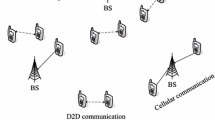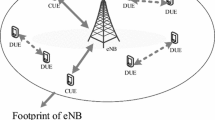Abstract
Device-to-device (D2D) communications facilitate a number of services that are based on the exchanged information and data that are within the proximity of mobile devices. To enable robust and effective D2D communications, the D2D control signal should primarily be successfully received, even when it has been subject to collision and interference that are caused by a large number of neighboring devices. Since the broadcast type of communication is generally considered for D2D services, the Tx-side operation should be designed for higher reception performances. By using channel-quality metrics such as the signal-to-interference-plus-noise ratio as the basis for revealing the relationship between the resource selection and the decoding probability, a novel resource-selection scheme to manage the interference and the in-band emission in terms of the transmission of scheduling assignment (SA) messages was developed in this paper. Through system-level simulations, and in contrast with the conventional SA-selection method, the proposed scheme increases the decoding performance.










Similar content being viewed by others
References
3GPP. (2013). Evolved Universal Terrestrial Radio Access (E-UTRA); Carrier Aggregation; Base Station (BS) radio transmission and reception, 3GPP TR 36.808, V10.1.0.
3GPP. (2010). Evolved Universal Terrestrial Radio Access (E-UTRA); Further advancements for E-UTRA physical layer aspects, 3GPP TR 36.814, V9.0.0.
3GPP. (2010). Evolved Universal Terrestrial Radio Access (E-UTRA); Relay architectures for E-UTRA (LTE-Advanced), 3GPP TR 36.806, V9.0.0.
3GPP. (2013). Evolved Universal Terrestrial Radio Access (E-UTRA) and Evolved Universal Terrestrial Radio Access Network (E-UTRAN); Overall description; Stage 2, 3GPP TS 36.300, V11.6.0.
3GPP. (2013). Technical Specification Group Services and System Aspects; Feasibility study for proximity services (ProSe), 3GPP TR 22.803, V12.1.0.
3GPP. (2013). Study on LTE device to device proximity services; Radio aspects, 3GPP TR 36.843, V12.1.0.
3GPP. (2013). Evolved Universal Terrestrial Radio Access (E-UTRA); Multiplexing and channel coding, 3GPP TR 36.212, V12.1.0.
McGlynn, M. J., & Borbash, S. A. (2001) Birthday protocols for low energy deployment and exible neighbor discovery in ad hoc wireless networks. In Proceedings of ACM international symposium on mobile ad hoc networking and computing, pp. 137–145.
Galluccio, L., Morabito, G., & Palazzo, S. (2004). Analytical evaluation of a tradeoff between energy efficiency and responsiveness of neighbor discovery in self-organizing ad hoc networks. IEEE Journal on Selected Areas in Communications, 22(7), 1167–1182.
Han, S. Y., & Lee, D. (2013). An adaptive hello messaging scheme for neighbor discovery in on-demand MANET routing protocols. IEEE Communications Letters, 17(5), 1040–1043.
Cohen, R., & Kapchits, B. (2011). Continuous neighbor discovery in asynchronous sensor networks. IEEE/ACM Transactions on Networking, 19(1), 69–79.
Zou, J., Wang, M., Zhang, J., Shu, F., Wang, J., Qian, Y., et al. (2013). Discovery signal design and its application to peer-to-peer communications in OFDMA cellular networks. IEEE Transactions on Wireless Communications, 12(8), 3995–4009.
3GPP. (2013). Technical Specification Group Radio Access Network; Evolved Universal Terrestrial Radio Access (E-UTRA); Physical channels and modulation, 3GPP TS 36.211, V11.3.0.
Cover, T. (1972). Broadcast channels. IEEE Transactions on Information Theory, 18(1), 2–14.
3GPP. (2013). Evolved Universal Terrestrial Radio Access (E-UTRA); User Equipment (UE) radio transmission and reception, 3GPP TR 36.101, V12.1.0.
Intel Corporation. (2013). System level analysis of the D2D broadcast communication in out of network coverage scenarios. 3GPP TSG RAN WG1 Meeting #75, R1-135116.
Baccelli, F., & Blaszczyszyn, B. (2009). Stochastic geometry and wireless networks volume I: Theory. Foundations and trends in networking. Breda: NOW Publishers.
Andrews, J. G., Baccelli, F., & Ganti, R. K. (2011). A tractable approach to coverage and rate in cellular networks. IEEE Transactions on Communications, 59(11), 3122–3134.
Weber, S., Andrews, J. G., & Jindal, N. (2010). An overview of the transmission capacity of wireless networks. IEEE Transactions on Communications, 58(12), 3593–3604.
Stoyan, D., Kendall, W., & Mecke, J. (1996). Stochastic geometry and its applications (2nd ed.). New York: Wiley.
ITU-R Report M.2135, Guidelines for evaluation of radio interface technologies for IMT-advanced, 2008.
Fraile, R., Monserrat, J. F., Gozalvez, J., & Cardona, N. (2008). Mobile radio bi-dimensional large-scale fading modelling with site-to-site cross-correlation. European Transactions on Telecommunications, 19(1), 101–106.
Goldsmith, A. (2005). Wireless communications, published by Cambridge, ISBN: 978-0-521-83716-3.
3GPP. (2012).Evolved Universal Terrestrial Radio Access (E-UTRA); Radio Frequency (RF) System Scenarios, 3GPP TR 36.942 V9.2.0.
Acknowledgements
This research was sponsored by Next Generation Communications Business Team of Samsung Electronics Co., Ltd., Korea and supported by Basic Science Research Program through the National Research Foundation of Korea (NRF) funded by the Ministry of Education (NRF-2010-0020210).
Author information
Authors and Affiliations
Corresponding author
Rights and permissions
About this article
Cite this article
Park, SH., Kim, J.S. & Chung, M.Y. Resource Selection Scheme for the Transmission of Scheduling Assignment in Device-to-Device Communications. Wireless Pers Commun 97, 4631–4649 (2017). https://doi.org/10.1007/s11277-017-4742-x
Published:
Issue Date:
DOI: https://doi.org/10.1007/s11277-017-4742-x




